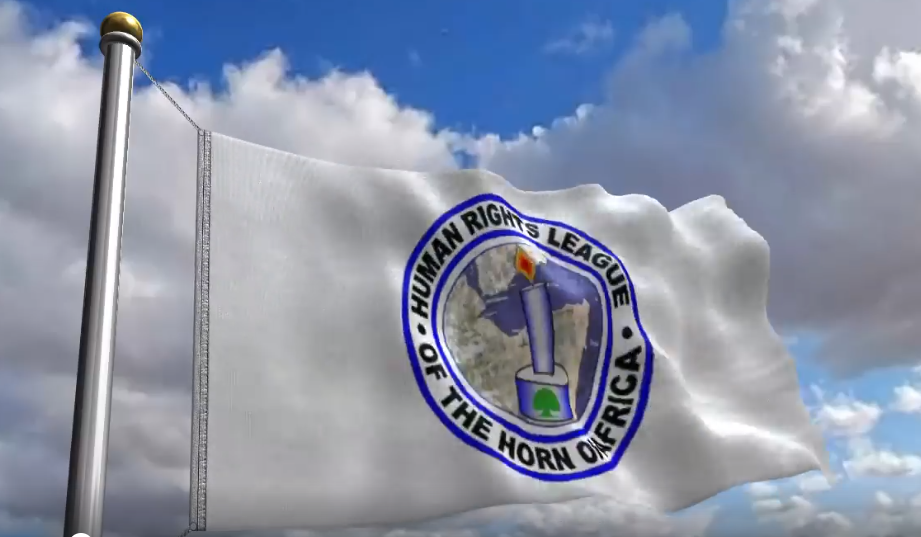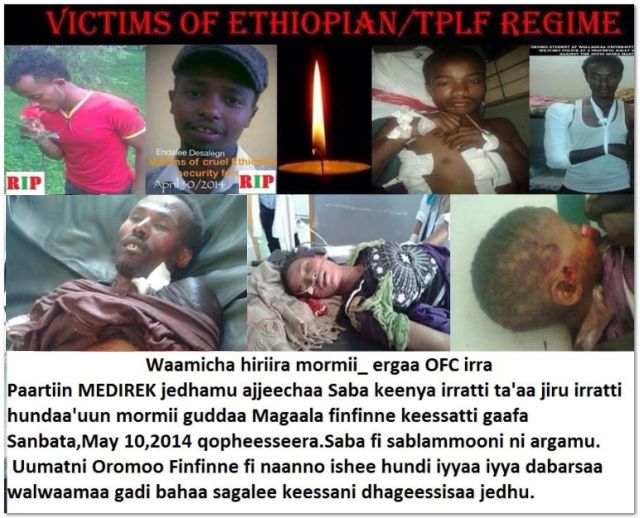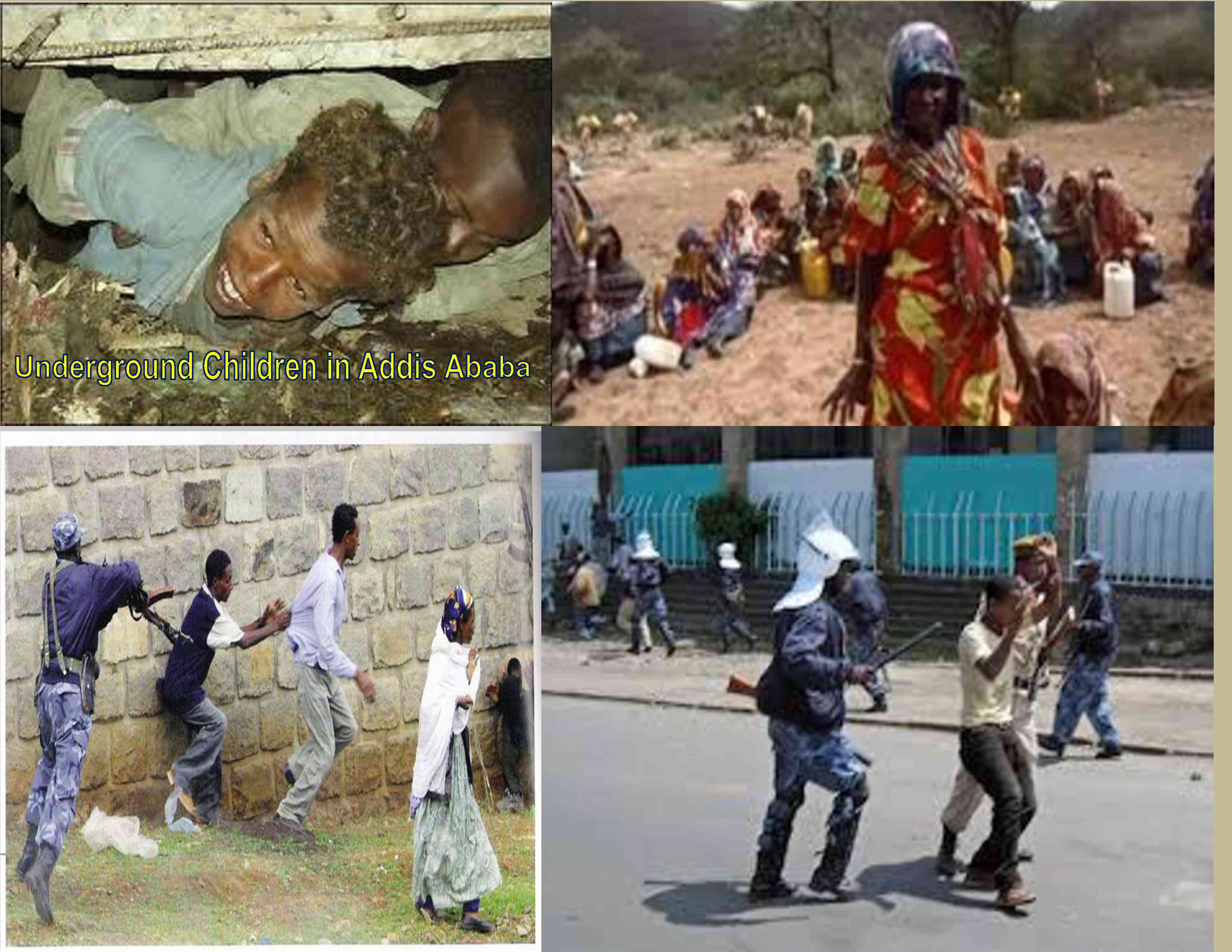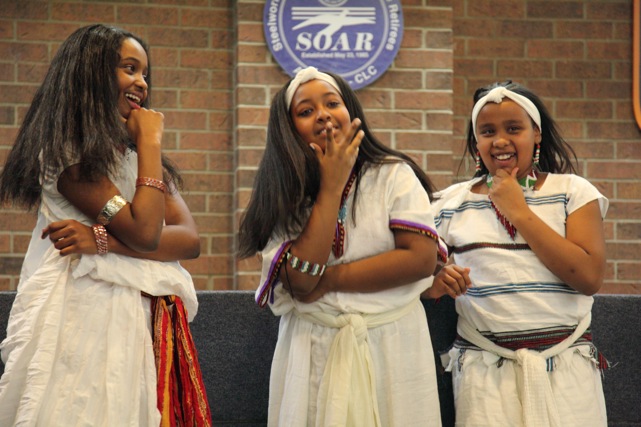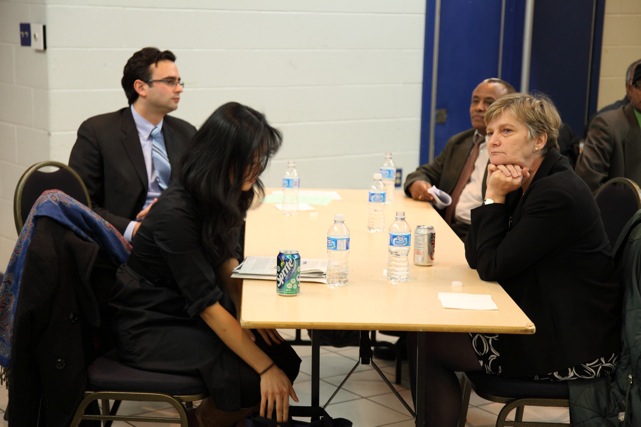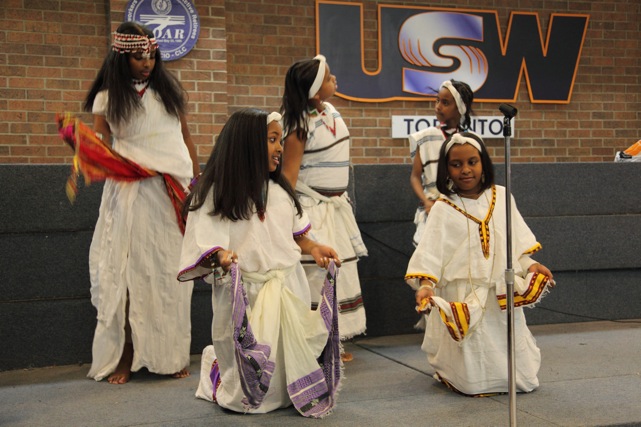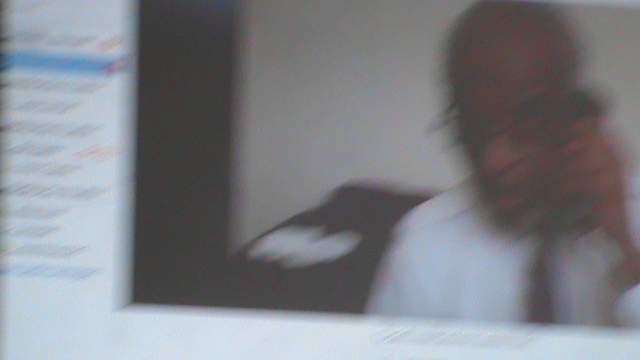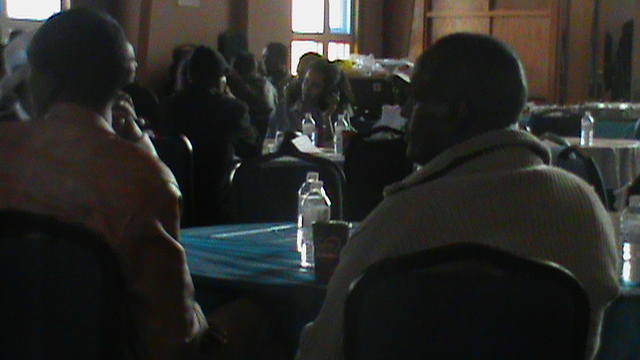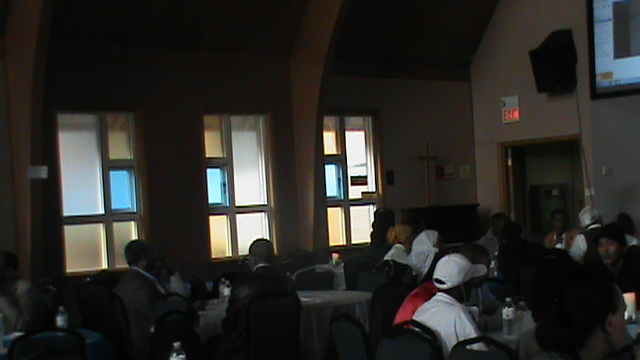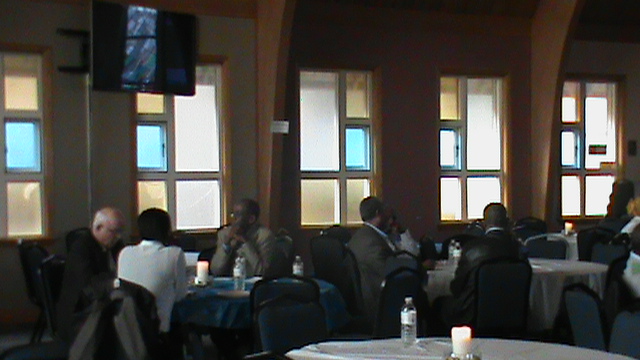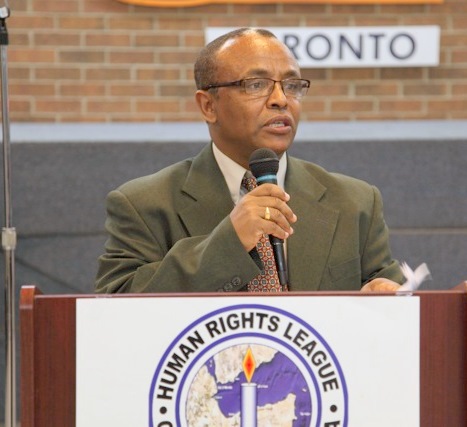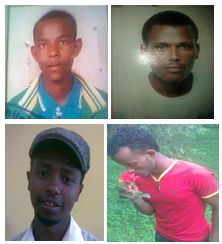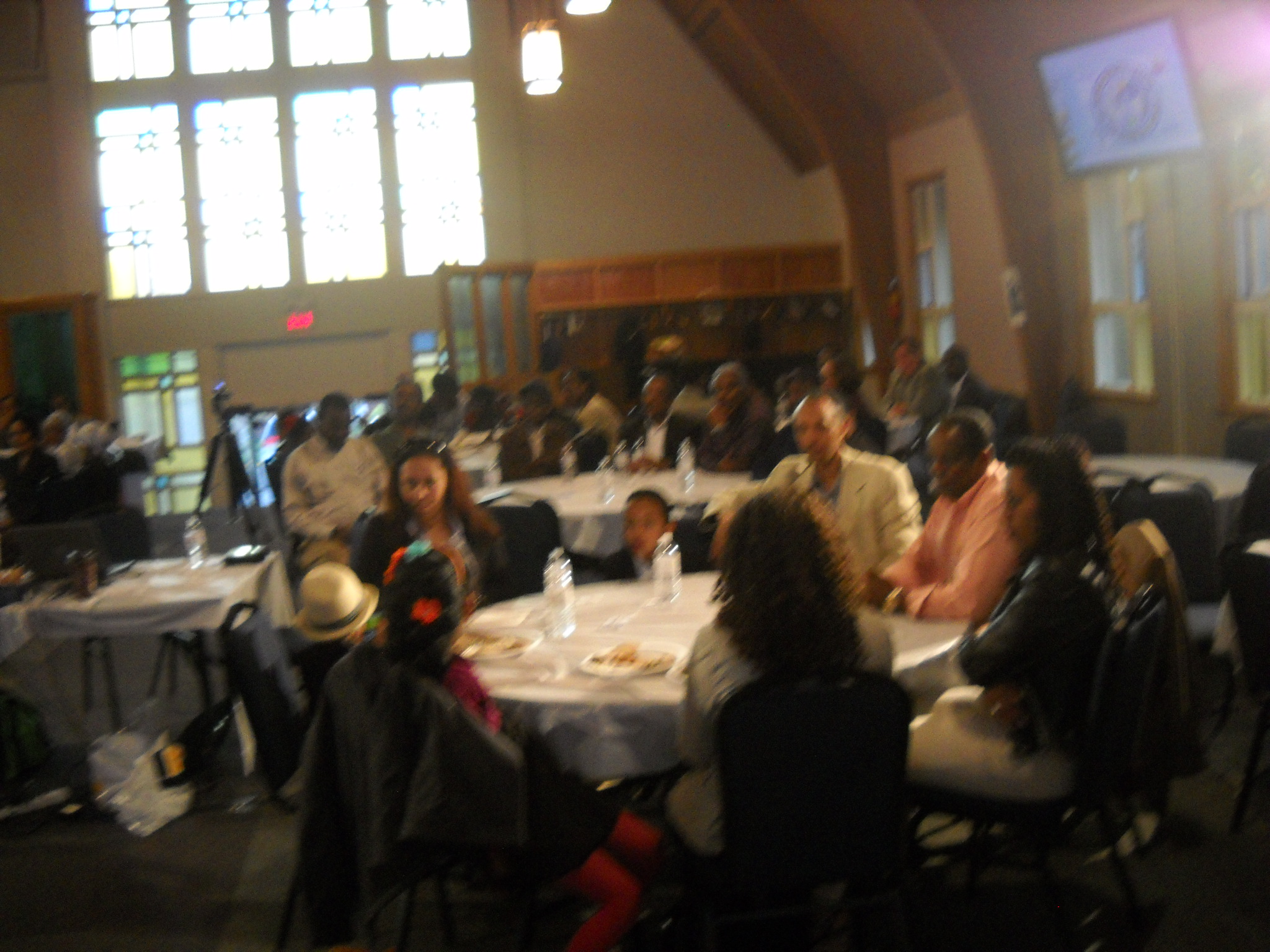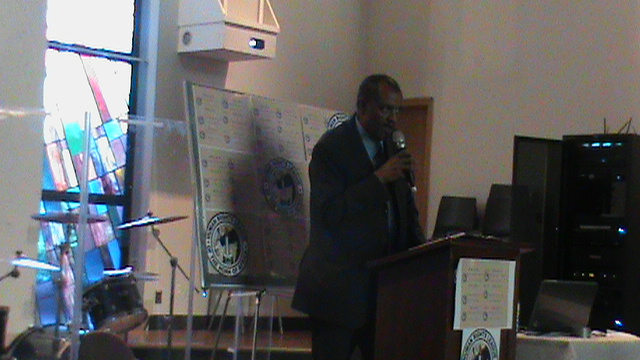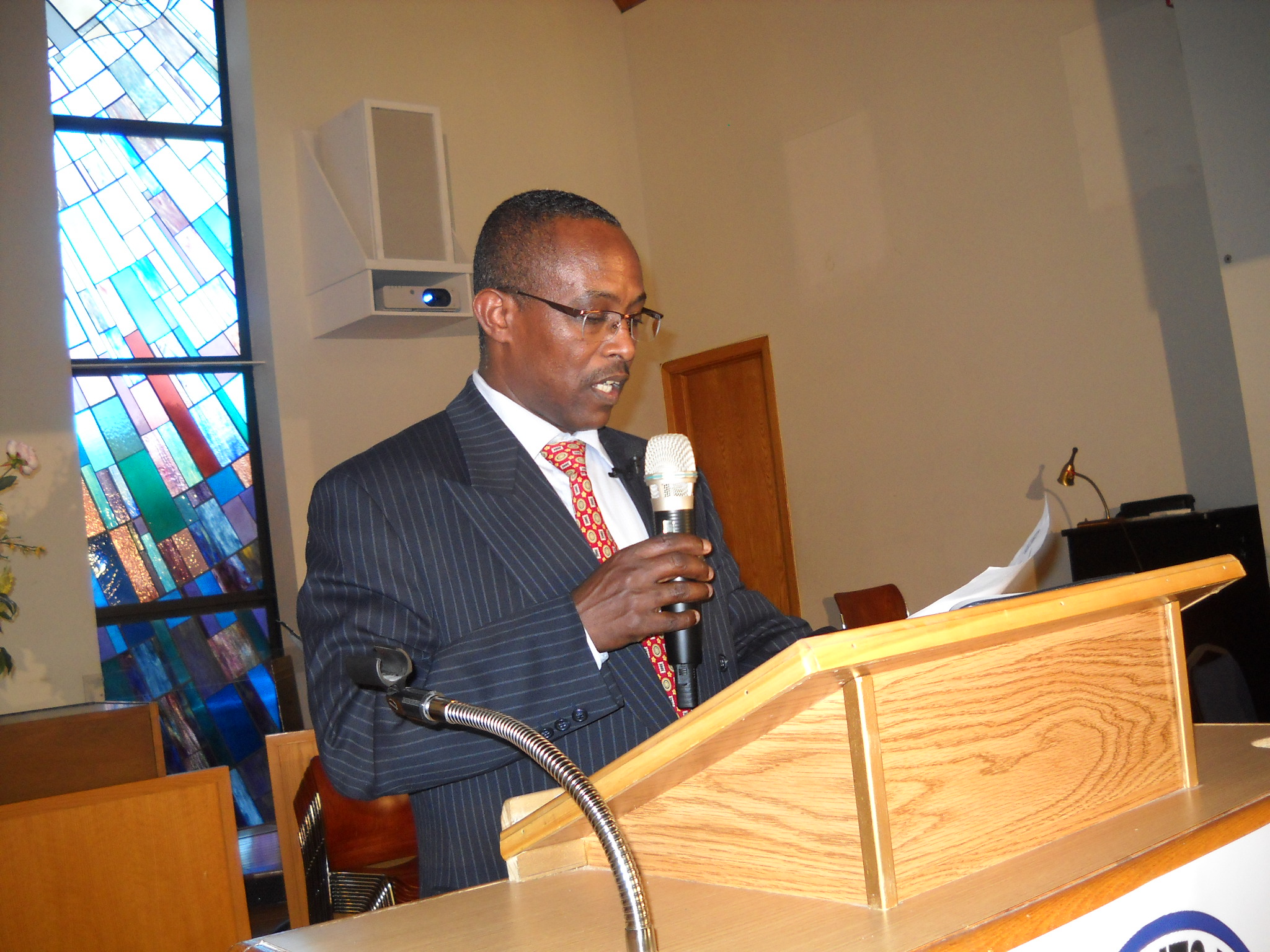Migration and Refugee Protection in the Horn of Africa
- § A Week with Ethiopian Immigrants in the Horn of Africa, Uganda
Garoma B. Wakessa,
Human Rights League of the Horn of Africa
Mission in Uganda – Human Rights League of the Horn of Africa Field Trip Report
March 2014
The Human Rights League of the Horn of Africa (HRLHA)
HRLHA is a non-profit, non-political and non-partisan human rights organization with a Special Consultative Status with the UN Economic and Social Council. It works on defending fundamental human rights including freedoms of thought, expression, movement and association. It attempts to challenge abuses of human rights of the people of various nations and nationalities in the Horn of Africa. It also works on raising the awareness of individuals about their own basic human rights and that of others. It encourages the observances as well as due processes of law. It promotes the growth and development of free and vigorous civil societies.
Human Rights League of the Horn of Africa (HRLHA)
994 Pharmacy Avenue Toronto, Ontario, M1R 2G7
Tel: (647) 280 7062
E-Mail: hrldirector@mail.org.
Web Site: www.humanrightsleague.com
|
Executive Summary
The field trip in Uganda in October 2013 was targeted on two important missions. The first mission was to facilitate the set-up of HRLHA’s regional office in Uganda. It was thought that this would help strengthen the involvement of HRLHA in communities of the region and enhance the efforts of the agency in the region. Over the past six years, the Human Rights League of the Horn of Africa (HRLHA) has compiled and disseminated a number of human rights violation reports in the Horn of Africa in general and in Ethiopia in particular using the information collected from its reporters in the region. This method of collecting information enabled the HRLHA to cover the human rights violations in the region only partially. To have more access to information and to expand HRLHA’s involvement in the region, the agency needed to create a base in one of the countries in the region. To that end the process of forming the regional branch office was started in October 2013 in Uganda/Kampala to make the long time dream true.
The second mission was to visit the asylum seekers and refugees in Kampala/ Uganda to study the protection of immigrants in this country. Uganda is one of the Horn of Africa countries where thousands of asylum seekers from Democratic Republic of Congo (DRC), South Sudan, Somalia, Rwanda, Burundi, Eritrea, Ethiopia, and Central Africa Republic are entering every month. More than 200,000[1] registered refugees who migrated from those countries and internally displaced people are residing in Uganda’s territory according to the UNHCR statistics of 2013. The immigrants are those who hold the UNHCR attestation papers and depend on UNHCR for their essential services and basic needs. There are also thousands of asylum seekers whose cases are pending or have been rejected by UNHCR and live in Kampala city in hard conditions- every three months they renew their asylum seekers paper given to them by the refugee commission of Uganda. Among the recognized refugees the majority are internally displaced people in Uganda due to the long war between the Ugandan Government and the Lord’s Resistance army. The Lord’s Resistance Army (LRA), also known as the Lord’s Resistance Movement, is a militant movement described by some as a new religious movement or a cult which operated in Northern Uganda and South Sudan. Since 2005, there have been claims that the group has entered the Democratic Republic of Congo, but in 2007 it was reported that they were in Central Africa Republic[2]. The RLA has been accused of widespread human rights violations, including murder and abduction[3]. According to the Uganda based UNHCR office report of 2013, around 180,000 Ugandans are getting assistance as returnees and internally displaced persons. The majority of asylum seekers from Ethiopia and Eritrea are complaining that the UNHCR office has rejected their asylum applications. Another challenge the asylum seekers are facing at present is lack of financial assistance to process their asylum case applications. Many of them specifically said they were having problems getting the $50.00 USD to pay the lawyers who would file their claims. The days I spent in Kampala did not really provide enough time to contact with many asylum seekers and refugees. Interviewing asylum seekers and refugees was one of the plans of the mission, but red tape was a problem. I was told by the Refugee Commission of Uganda office that visiting the refugee camps required permission. To process the permission would take fifteen working days. I had only seven days to return back to Canada. So, this pre-condition forced me to make a major shift in my plans of visiting the refugee camps.
Acknowledgements
I have taken much effort to make this mission productive. However, it would not have been possible without the kind support and help of HRLHA’s Board of Directors, staff members and many individuals to make it real. I would like to extend my sincere thanks to all of them. I am highly indebted to Mr. Gemechis Niyata for his assistance – from the very first day of my arrival in Kampala/Uganda until I concluded my mission. He was always beside me during my nine days stay in Kampala. Visiting the NGOs Board office in Kampala to register HRLHA as a regional branch would have been difficult without his help. He also greatly facilitated my visit to the Prime Minister’s Office of the Refugee Commission of the Republic of Uganda. I would like also to express my special gratitude and thanks to Oromo asylum seekers and refugee community members in Kampala for giving me such attention and their time by attending the public meeting. Those immigrants who took time away from their work and participated in interviews are highly appreciated. My thanks and appreciation also goes to the Refugee commission of the Republic of Uganda and its secretary, and the Human rights organizations in Kampala, all of whom I met with for their sincerely welcoming me and for being generous with their precious time and information. Lastly, I would like to express my gratitude towards my family for their kind co-operation and encouragement during my preparation to travel to Uganda and for their patience and help in compiling this research report.
Table of Contents Page Human Rights League of the Horn of Africa (HRLHA) ———————————-4
Executive Summary ————————————————————————–5
Acknowledgements—————————————————————————7
Table of Contents —————————————————————————–8
Methodology ———————————————————————————-9
Introduction———————————————————————————-10
Uganda and the Kingdom of Buganda —————————————————-12
The Origin of Buganda ———————————————————————-12
Mixed Migration in the Horn of Africa, the Main Drives and Motivation————-14
Refugee and Human Rights—————————————————————–15
Global Refugee Problem and Refugee Protection—————————————17
International refugee law and the refugee situation in the Horn of Africa ————18
Asylum Seekers and Refugees in Uganda————————————————-21
Mission in Uganda—————————————————————————22
Ethiopian Asylum Seekers and Refugees in Neighboring Countries and Beyond—-25
The Risky Journey of Ethiopian Immigrants to Uganda——————————–27
Interviews ————————————————————————————28
Paying Maximum Price in order to survive———————————————–28
Father tortured to death——————————————————————–33
Public Meeting ——————————————————————————-37
Conclusion ———————————————————————————-38
Methodology
|
|
This report is mainly based on the information collected from refugees and asylum seekers I met on streets, in restaurants and coffee shops in Kampala city and in formal interviews conducted with Ethiopian immigrants in Kampala/Uganda during a week of my trip mission to Uganda in October 2013. The HRLHA’s human rights violation reports on the Horn of Africa in the past six years were also used as the background for this research report. Contacting the asylum seekers and refugees to discuss their refugee protection rights issues was part of the mission. In this regard, seven interviews were conducted. Each interview took an average of 45 minutes. During the interviews, interviewees were informed that the information obtained from each of them would be published and distributed for public consumption. Unfortunately female refugees or asylum seekers did not participate in these interviews because they were not available at interview times. See the names of the interviewees below
|
|
1
|
|
|
|
No |
Name |
Age |
Gender |
Birth Place |
||
|
1 |
IrkisaTesemma Dayas |
39 |
M |
Wallaga, Gidda Ayana |
||
|
2 |
Engida Belyneh Shenkor |
47 |
M |
North Shewa Merabet |
||
|
3 |
Sena Sori Immana |
33 |
M |
West Shewa, Ambo |
||
|
4 |
Sisay Tekle Zemedkum |
30 |
M |
North Shewa , Lemi twon |
||
|
5 |
Adane Benti Hunde |
45 |
M |
Wallaga, Gimbi |
||
|
6 |
Samu’l Geesisa Hunde |
26 |
M |
Wallaga, Mendi |
||
|
7 |
Humnasa |
20 |
M |
|
||
Introduction
Refugee Migration is one of the biggest problems in the world. People regularly leave their home countries to reside elsewhere. For all of them, the main causes for migration are fear of being persecuted for reasons of race, religion, nationality, membership in a particular social group or political opinions and other reasons. Today, migration in the Horn of Africa within the continent and beyond- to Middle East countries- has become a very complex challenge to the humanitarian and international community. The Refugee migration flow in the region increases year after year. People in significant numbers are escaping from their homelands to unknown destinations seeking for basic needs and safe places to live. Thousands of people from war- weary countries like Somalia, through fear of political persecution from Ethiopia and Eritrea are migrating long distances- even as far as to Arab Countries like Saudi Arabia and other countries. To get there, migrants use different ways to travel. Some walk through forests and deserts where most of the time they are exposing their lives to danger. Those who can afford to pay large amounts of US dollars can get some help from smugglers and traffickers; that, however, can cause problems. Regardless, no one is guaranteed a safe arrival at their wished destination.
The International Organization for immigration/IOM statistical data[4] indicates that the number of immigrants in East Africa has increased in comparison with other parts of the world. This increase in numbers of immigrants will continue unless there are ways to reduce the main causes of immigration such as poverty and political intolerance in the Horn.
People need food, clothing, shelter, schooling, health care, and etc wherever they reside as refugees until they receive permanent resettlements. More than anything else, security is the most important issue for desperate immigrants. Many reports indicate that in different parts of the world where there are refugee camps, refugees are exposed to various human rights violations from the security agents of the country where they reside and sometimes from the government agents of their home country. Human rights violations against refugees are widespread and all kinds. Nowadays the situation of refugees in the Horn of Africa is very alarming. Many documents show that the over flow of people (mass exodus) in the Horn of Africa is overwhelming the UNHCR- they are unable to provide necessary assistance like food, shelter, health care assistance and human rights protection. Many independent human rights organizations including HRLHA are reporting on the human rights violations committed against refugees in refuge countries. They are under severe human rights violations including sexual abuse, imprisonment, killings, unwilling deportation to their home country. To halt such misery, first of all it is the responsibility of the governments of that region. All national, regional and international civil organizations including United Nations and African Union Organizations have to put pressure on those abusive governments to respect and promote human rights standards in their country. Donor Governments such as the USA, the UK, Canada and other European countries also should play important roles and implement their foreign policy of “no respect for human rights, no financial assistance” to those governments who are violating human rights.
Uganda and the Kingdom of Buganda,
Origin of Buganda
The history of Uganda shows that the part of Uganda known as Buganda was earlier known as Muwaawa-in the 12th century, it meant a place that was sparsely populated. It is believed that the people of Buganda came from Abyssinia through the rift valley and the mountains of Elgon[5].
Buganda is a sub-national Kingdom within Uganda, the Kingdom of Ganda People. Luganda is the native language of the people of Buganda. Buganda is the largest of the traditional kingdoms in present-day Uganda, comprising all of Uganda’s Central Region, including the Ugandan capital Kampala. The 5.5 million Baganda (singular Muganda; often referred to simply by the root word and adjective, Ganda) make up the largest Ugandan ethnic group, representing approximately 16.9% of Uganda’s population.[6] Buganda has a long and extensive history. Unified in the fourteenth century under the first king Kato Kintu, the founder of Buganda’s Kintu Dynasty, Buganda grew to become one of the largest and most powerful states in East Africa[7] during the eighteenth and nineteenth centuries. During the scramble for Africa, and following unsuccessful attempts to retain its independence against British Imperialism, Buganda became the centre of the Uganda Protectorate [8]in 1894; the name Uganda, the Swahili term for Buganda, was adopted by British officials during the occupation years.. Under British rule, many Bugandas acquired status as colonial administrators, and Buganda became a major producer of cotton and coffee. Following Uganda’s independence in 1962, the kingdom was abolished by Uganda’s first Prime Minister Milton Obote in 1966. Following years of disturbance under Obote and dictator Idi Amin, as well as several years of internal divisions among Uganda’s ruling National Resistance Movement under Yoweri Museveni, the President of Uganda since 1986, the kingdom was finally restored in 1993. Buganda is now a kingdom monarchy with a large degree of autonomy from the Ugandan state, although tensions between the kingdom and the Ugandan government continue to be a defining feature of Ugandan politics. Since the restoration of the kingdom in 1993, the king of Buganda, known as the Kabaka, has been Muwenda Mutebi II. He is recognized as the thirty-sixth Kabaka of Buganda. The current queen, known as the Nnabagereka, is Queen Sylvia Nagginda. Buganda’s boundaries are marked by Lake Victoria to the south, the River Nile to the east, Lake Kyoga to the north and River Kafu to the northwest.[9] To the west, Buganda is bordered by the districts of Isingiro, Kiruhura, Kyenjojo, Kibale, Hoima andMasindi.
Kampala City is sited on a big hill named Mengo Hill. Mengo Hill has played an important role in Ugandan political and religious history. “Mengo” is a Luganda word for grinding stones. Migrant communities from Ssese Isands [10] who settled on the hill used these stones to grind their food.
Mixed Migration and the main drivers motivating migration in the Horn of Africa
Migration (human) is the movement of people from one place in the world to another. Migration can be internal or external. People can either choose to move by their own free will to fulfill their unlimited needs (“voluntary migration”) or be forced to move from fear of persecution or violence (“involuntary migration”). In the Horn of Africa, both voluntary and involuntary migrations from one country to another – by crossing the porous borders of neighboring countries- is a very common phenomenon. Pastoralists move voluntarily from one area to another area within their territory or sometimes beyond to find grazing land for their cattle. For the purpose of this research we will focus only on an involuntary migration by which people are forced to move from their home land to another place within their country of birth (internal displacement) or out of their country to neighbor countries and beyond to seek for their basic needs of survival from natural disasters such as flood, earthquake, starvation or to seek for a peaceful and safe place from civil war, or from fear of political and religious persecutions.
In the past few decades, the Horn of Africa has been the most conflicted corner of the world. The over two-decades long civil war in Somalia has turned the country into a stateless entity for so long and that has severely impacted the stability in the region. The 1998-2000 border war between Ethiopia and Eritrea, which claimed more than 70 thousand deaths and thousands of displaced people, is still unsolved. There is still the possibility of further war. The war between Sudan and South Sudan which had left over two million dead and more than four million people displaced ended in 2005. However, after the independence of South Sudan in 2013 the border conflict of Abbey between Sudan and S. Sudan, and the atrocity in Sudan Darfur are still unsolved problems. These and others are some of the reasons that have made the region a land of vulnerability and are the origins of the large number of migrants and refugees in the world next to the Middle East and North Africa. Though these problems exist in many other parts of the world, I am not sure if many of them occur in such frequency or persistence elsewhere.
As stated above, the majority of people migrate to save their lives and to escape from natural or manmade risks. On the other hand, the number of people who migrate voluntarily to find a better job to live a better quality life cannot be underestimated. This type of migration, which consists of both voluntary and involuntary types and using no planned route, is a “Mixed Migration”. The Horn of Africa is the big source for several mixed migration flows. Mixed migration basically involves people of different interests in migrations using different mechanisms to reach their wished destinations. For example, Mixed Migration by land and by sea from the Horn of Africa to Yemen is steadily increasing. According to the recent UNHCR statistical data of 2013, from January to the end of September, 23,086 Somali and 84, 446 Ethiopian (92% Oromos) new asylum seekers have arrived at Yemen’s coast. This number doesn’t include those thousands drowned in the Gulf of Aden, as different human rights organizations including HRLHA indicated in their periodical or non-periodic reports in 2013.
Refugee and Human Rights
Definitions of refugee come into play when countries and organizations attempt to determine who is and who is not a refugee. According to the UN refugee convention of 1951, article 1 A (2) relating to the status of refugees, a refugee is defined as a person who “owing to a well-founded fear of being persecuted for reasons of race, religion, nationality, membership of a particular social group or political opinion, is outside the country of his nationality, and is unable to or, owing to such fear, is unwilling to avail himself of the protection of that country or return there because there is a fear of persecution”[11]
In the UN convention of refugees of 1951, race and religion are used in the broadest sense. Race includes ethnic groups and social groups of common descent, and religion is identification with a group that tends to share common traditions or beliefs, as well as the active practice of religion, while nationality includes an individual’s citizenship. Persecution of ethnic, linguistic and cultural groups within a population also may be termed persecution based on nationality. A particular social group refers to people who share a similar background, habits or social status. This category often overlaps with persecution based on one of the other four grounds. It has applied to families of capitalists, landowners, homosexuals, entrepreneurs and former members of the military. Political opinion refers to ideas not tolerated by the authorities, including opinions critical of government policies and methods. It includes opinions attributed to individuals (i.e., the authorities think a person has a certain political opinion) even if the individual does not in fact hold that opinion. Individuals who conceal their political opinions until after they have fled their countries may qualify for refugee status if they can show that their views are likely to subject them to persecution if they return home. Journalists, singers, and some academics are those who hold most of the time different opinions from their governments and are subjected to prisons, torture and persecution.
In Ethiopia today, the main causes why people migrate to another country are political, economical and racial discriminations by the minority dominated government of Ethiopia. The unfair and unequal treatments of individuals, nations and nationalities and political and civil institutions in Ethiopia by the present TPLF/EPRDF government have led the country to unstoppable conflicts in Oromia and Ogaden regional states in the past two decades. At the federal level, the high posts in military[12] and other government institutions are controlled by individuals from one ethnic group, Tigre. Today, Oromo and other national individuals are marginalized from meaningful governmental positions. Large business organizations are owned by-Tigre individuals or organizations. Thousands of Oromos and others who became victims of the system were/are forced to leave their country behind and lead a miserable life as refugees in neighboring countries where their asylum rights are also denied by most of those states.
Global Refugee Problems and Horn of Africa Refugee Protection
When the UNHCR was established by the UN General Assembly in 1951 using the mandate enshrined in Article 14 (1) of the Universal Declaration of Human Rights (UDHR), “Everyone has the right to seek and to enjoy in other countries asylum from persecution” to protect and assist refugees, there were around one million refugees. Today, 63 years later, the UNHCR statistical data of 2013 shows that the number of forcibly displaced persons of concern to UNHCR globally exceeds over 45.2million[13]. About two-thirds of the world’s forcibly uprooted people are internally displaced peoples (IDP) within their own country[14]. At the end of 2012, the UN refugee agency was assisting around 15.5 million of these IDPs, more than the total number of refugees of concern to UNHCR. Like refugees, they were forcibly displaced by conflict, generalized violence and human rights violations. Today, the UNHCR regional and branch offices in the Horn of Africa Countries assist the largest number of refugees. The following chart shows the total number of refugees and asylum seekers from Somalia, Eritrea, Sudan and Ethiopia residing in neighboring countries and Yemen. The data is collected from UNHCR 2014 planning figures for each country. Yemen is considered as the passageway to the final desired destination of Saudi Arabia for the migrants mainly from these countries of the Horn.
| Origin | Type of Population |
Host Country |
|||||||||
| Djibouti | Eritrea | Ethiopia | Kenya | Somalia | Sudan | S. Sudan | Uganda | Yemen | Total | ||
|
Djibouti
|
Refugee | – | – |
– |
– |
– |
– |
– |
– |
– |
– |
| AS | – | – |
– |
– |
– | – |
– |
– |
– |
– | |
|
Eritrea |
Refugee | 400 | – | 86010 |
– |
50 | 118,280 |
– |
– |
– |
204,740 |
| AS | 900 | – | 50 | – | 60 | 2,010 | – | 4,460 |
400 |
7,880 | |
|
Ethiopia |
Refugee | 510 | – | — | 21,610 | 2550 | 5,100 | 6000 | – |
6,100 |
41,870 |
| AS | 3,230 | – | – | 11,110 | 14,170 | 5,380 | – | – |
7,500 |
41,390 | |
|
Kenya |
Refugee | – | – | – | – | – | – | – | – |
– |
– |
| AS | – | – | – | – | – | – | – | – |
– |
– | |
|
Somalia |
Refugee | 20,190 | – | 238,920 | 482,390 | – | – | – | 23,570 |
244,000 |
1009070 |
| AS | 40 | – | 200 | – | – | – | – | 5,790 |
– |
6030 | |
|
S. Sudan |
Refugee | 82,090 | 14,200 | – | – | – | 16,980 |
– |
113,270 | ||
| AS | – | – | 300 | 29,090 | – | – | – | – |
– |
29,390 | |
|
Sudan
|
Refugee | – | – | – | – | – | – |
– |
– | ||
| AS | – | – | – | – | – | – | 212,800 | – |
– |
212,800 | |
|
Uganda |
Refugee | – | – | – | – | – | – | – | – |
– |
– |
| AS | – | – | – | – | – | – | – | – |
– |
– | |
| Various | Refugee | 20 | 3457 | 4, 220 | 20,070 | 20 | 1,080 | 1700 | 44,360 |
240 |
75,167 |
| AS | 50 | 6 | 250 | 17,310 | 30 | 180 | 50 | 8,560 |
400 |
26,836 | |
| Total | 25,340 | 3,463 | 412,040 | 595,780 | 16,880 | 132,030 | 22,0550 | 103,720 | 25,8640 | 1,768,443 | |
International refugee law and the refugee situation in the Horn of Africa
In the Universal Declaration of Human Rights Article 14 (1) “everyone has the right to seek and to enjoy in other countries asylum from persecution”[15]. People who already left their country behind have the right to have a shelter and protection from the country he or she resides as a refugee. In addition, the convention against torture and other cruel, inhuman or degrading treatment or punishment under article 3/ (1,2) states, “no State Party shall expel, return (“refouler”) or extradite a person to another state where there are substantial grounds for believing that he would be in danger of being subjected to torture, and for the purpose of determining whether there are such grounds, the competent authorities shall take into account all relevant considerations including, where applicable, the existence in the state concerned of a consistent pattern of gross, flagrant or mass violations of human rights”[16]. African governments fully accepted the 1951 UN convention relating to the status of refugees in their OAU refugee convention of 1969 under its Preamble (9) as “Recognizing that the United Nations Convention of 28 July 1951, as modified by the Protocol of 31 January 1967, constitutes the basic and universal instrument relating to the status of refugees and reflects the deep concern of States for refugees and their desire to establish common standards for their treatment,”
The international refugee law explains the prohibition of forced return (non-refoulement) of a refugee to his or her country of origin. Prohibition of the forced return of a refugee is one of the most fundamental principles in the international refugee law. [17] The Convention Relating to the Status of Refugees, article 33 says that no state “shall expel or return (‘refouler’ in French) a refugee in any manner whatsoever to the frontiers of territories where his life or freedom would be threatened on account of his race, religion, nationality, membership of a particular social group or political opinion.”[18] Asylum seekers often leave their country quickly without any legal documents, in order to save their lives. Because of this, some countries detain asylum seekers upon their arrival, during the asylum process or while waiting for deportation (refoulement), breaching the international agreements. Asylum seekers may have already suffered imprisonment and torture in the country from which they have fled. Therefore, the consequences of detention may be particularly serious, causing severe emotional and psychological stress. In addition to the refugee law, Article 31 of the Refugee Convention says that “refugees should not be penalized for having entered a country illegally if they have come directly from a place where they were in danger and have made themselves known to the authorities”.[19] Therefore, asylum seekers should not be detained for being in possession of forged identity papers or for destroying identity or travel documents. Governments normally guarantee the basic human rights and physical security of their citizens. They also bear the prime responsibility for protecting refugees on their territory. But when civilians flee their home country and become refugees, this safety net can often disappear.
Asylum seekers often cross borders without any legal documents. Upon their arrival in the second country they are automatically exposed to many challenges. Without some sort of legal status in their asylum country, they would be exceptionally vulnerable to exploitation and other forms of ill treatment, as well as to imprisonment or deportation. Many civil authorities, organizations, those who are aware of the mishandling of the refugees by government advocate against such acts. The only organization mandated to deal with the protection of such vulnerable refugees is the UNHCR. The UNHCR all over the world is trying to protect the refugees from any kind of physical and psychological abusers. They attempt to promote or provide legal and physical protection, and minimize the threat of violence – including sexual assault – which many refugees are subject to, even in countries of asylum. However, all of the efforts of UNHCR staff members cannot change the vulnerability of the immigrants- especially when the rights of refugees and asylum seekers are violated everyday in refuge countries. Violating the international treaties and international human rights standards, the governments of the Horn of Africa in the past several years have arbitrarily arrested, tortured and deported hundreds of Ethiopia refugees including those who had UNHCR status. Many Ethiopia refugees who were registered with UNHCR and had been given refugee status have been deported from Djibouti, Kenya, Sudan, States of Somalia (Puntiland and Somaliland) in the past twenty years. For example, in 2008 Kadir Hasan Ahmed, age 17, male, Fatih Mohamed Ali, age 16, male, Abdul Aziz Ahmed Hajii muhamed, age 17, male and, Muhamed Abdoo Ahmed, age 17, male were arrested, tortured in Djibouti and deported to Ethiopia. On the 22nd of May, 2013 in front of the UNHCR Office, Djibouti branch, nine Ethiopian refugees were arrested[20] and tortured in Djibouti by security forces. Refugees in the Horn of Africa are people extremely at risk of human rights violations in their home country as well in the neighbor countries. They are subject to forcibly return ( refoulement) to the country they flee from persecution. If they are returned home, they would face extreme human rights violations such as torture and routine imprisonment- even the death penalty. For example, Engneer Tesfahun Chemeda, who died on August 24, 2013 in Ethiopia’s grand jail of Kaliti due to torture that was inflicted on him there, was handed over to the Ethiopian Government Security Agents in 2007 by the Kenyan Government.
Asylum seekers and refugees in Uganda
Among African states, Uganda is one of signatory countries to all principal international legal documents for refugee protection, the 1951 Refugee Convention, the 1976 Protocol and the 1969 OAU (Organization of African Unity) Convention. What makes Uganda different from the rest of the Horn of Africa States is, in addition, the international documents Uganda adopted new progressive refugee legislation[21] ” the Refugees Act of Uganda”, in 2006 that proved the commitment of the country to implement the international standards of refugee protection legal documents. The Act recognizes the right of refugees to work, to move freely within the country and to live in the local community, rather than in settlements.
With a less-stringent refugee policy, and honoring its international obligations than neighboring states, and its relative peace, Uganda became an attractive destination for refugees coming from the neighboring countries and beyond. Documents indicate that as of 2013, the country has hosted approximately 200,000 refugees/asylum seekers from diverse nationalities[22], from Somalia, DRC, Eritrea, Ethiopia, Rwanda and other places. These refugees are spread across several settlements throughout the country, and within the capital. Among many refugee camps in Uganda the three major camps are Nakvale, Kampala, and Kyangwali.
|
Location |
Number |
% of overall total |
|||
|
Nakivale |
63346 |
32% |
|||
|
Kampala |
51469 |
|
|||
|
Kyangwali |
21775 |
11% |
|||
|
Other Locations |
61369 |
31% |
|||
| Overall total | 197959 | 100% |
Mission in Uganda
My long time contact, Gamachis Nyata, a person whom I met physically for the first time in Kampala during my mission on October 22, 2013, has made enormous contributions to this mission’s success.
My first day in Kampala started in my hotel room. Gammachis arrived at my hotel room at 8:30 am on October 23rd. He drove us to his home first where I met seven Oromo asylum seekers (five men and two ladies) who share one home with two bedrooms. They were very eager to meet with me. They welcomed me with a great pleasure, offered me to have a breakfast with them. As we had breakfast, I had a chance to speak with all seven of them on the story behind their immigrating to Uganda. Among them there was a young boy of 17 Eba Kebede , a high school graduate who just arrived before two days from Kenya. Another one was a gentleman who told me he arrived in Kampala two weeks ago direct from Ethiopia. He told me that he had worked for Oromia regional state on different government positions for the last fifteen years. He was not only a civil servant, but an active member of OPDO/EPRDF, the Ethiopian ruling party. He left his country and his job after disagreeing with the party officials about the injustices they have been committing against Oromo Nation. He told me that out of fear of being persecuted he had fled to Uganda. All had the same reasons for escaping: fear of arrest and torture. I thanked them all, for the warm receiving and the good breakfast and valuable conversation about their issues and we left home around 11:00 am local time. Around 11:30 am we reached at Ugandan NGOs Board and presented HRLHA’s application for registration to the authorities of the NGOs Board and the process was started. After filling out the necessary documents, I left for another day of appointments.
Another plan of my mission was to conduct interviews with refugees and asylum seekers in Uganda/Kampala. My priority was to travel to camp locations and visit the refugees. I was told by my informants that the refugee camps are located far from the capital Kampala, and prior to travel to the camps, permission from the office of the Prime Minister’s Refugee Commission was a must. Early morning on October 24, 2013 I drove with Gemechis to the Prime Minister’s Refugee Commissioner office. Upon our arrival I witnessed at the entrance of the office a long lineup of women, men, young boys and girls with forms in their hands. The security was very tight. We showed our ID and were searched from top to bottom. Then we were allowed to get into the building. I presented to the front desk customer service the reason for my presence at the Refugee Commission office. I was allowed to proceed to the Commissioner’s office. I met the Secretary and introduced myself to her and explained that I wanted permission to visit Nakvale refugee camp, about 400km away from the capital city. She said, “The first step is you need to bring the request paper with the organization’s head letter and submit it to the commissioner’s office- then the commissioner will look at it and give a decision”. We left the Commissioner’s office to prepare the request paper. After an hour we returned. I was allowed to present this to the Commissioner by myself. The Commissioner welcomed me and offered me to sit. He was a very humble person. I handed over my request letter introducing myself and my role as a human rights activist. After he read the request letter he welcomed it. Unfortunately, too many visitors had received permissions for the day I indicated in my application to visit the camps: “I can’t issue more permission paper now to receive a visiting permission to travel to the refugee camps our office needs two weeks’ notice to process your request” he said. I explained to the commissioner that I had a tight schedule. The commissioner was very eager to know why I preferred to visit the Nakivale refugee settlement and asked “Why Nakivale refugee settlement is your preference? We have more than 63,000 refugees in this camp from different countries (DRC, Somalia, Rwanda, Burundi, Eritrea and Ethiopia) and which refugees you want to interview and about what…” He asked multiple questions one after another. I replied that my priority was to interview refugees from Ethiopia, Eritrea and Somalia. He wanted to know whether I had been in a refugee camp in my early days prior to receiving asylum in Canada. I explained to him that I had never stayed in any refugee camps. I realized by now that visiting any of the refugee camps out of Kampala was impossible due to the time constraint.
Prior to my visit to the Prime Minister’s Refugee Commission office, I collected some information about the refugee situation in Uganda. There are three refugee camps around Kampala, two out of Kampala which are considered as rural resettlement camps: Nakivale refugee settlement, located near the Tanzania border in Isingiro district, Southern Uganda, hosts the largest number of refugees in the country, about 63,000 and Kyangwali refugee settlement lies in Hoima district in Western Uganda, near Lake Albert – the natural boundary between DRC and Uganda.
The third is in Kampala City; it is is considered Uganda’s second largest refugee hosting location, next to the Nakivale settlement. As of 2013 the estimated number of refugees residing in Kampala city was more than 51,000. The government of Uganda works very hard to motivate the immigrants by giving them work permits to settle in urban areas for a number of reasons including improved access to employment opportunities, better education and better social services.
In Kampala City, refugees are scattered in the city’s low-income areas. But there are certain neighborhoods where refugees from the same country of origin concentrate: for example, Somali refugees in Kisenyi, Congolese refugees in Katwe and Ethiopian refugees in Kabalagala.
Because of the time constraints I focused on interviewing Ethiopian and Eritrean refugees living in Kampala. However it was not easy contacting scattered refugees who are running to work to make money. Because of this I managed to have formal interviews only with seven Ethiopians, five from Oromo- the rest were two Amhara nationals. The cases of five of them are included in this mission report paper.
Ethiopian Immigrants in neighboring countries and beyond
Different international human rights organizations including HRLHA and international mass media have reported in the past two decades that thousands of Ethiopians have been migrating to neighboring countries and beyond- to North Africa, to Libya, Tunisia, Algeria and from there to Europe by boat (Malta, Italy) where hundreds have drowned at sea. Thousands migrate towards the South of Africa, to Tanzania, Malawi, Mozambique, Zimbabwe to end up in South Africa. The immigrants usually took dangerous routes to reach those countries. Hundreds lost their lives of hunger, some are eaten by wild animals in forests; thousands are drowned at sea. Those who arrived after so many challenges were rounded up by police and the security agents of those countries and ended up in prisons where they were exposed to humiliation, and human rights violations of all kinds. For example the Kenyan Daily Nation News paper reported on February 24, 2014
“Twelve Ethiopian illegal immigrants walked for nine months to Zimbabwe to escape religious tensions in the Horn of Africa nation, a court was told on Monday. They were arrested late last year in Bulawayo/Zimbabwe second largest city but the trial delayed because of lack of an Amharic interpreter. On Friday, they were sentenced to three months in prison, which was wholly suspended for five years on condition they do not remain in Zimbabwe without proper documentation. “I walked for nine months to Zimbabwe because of religious tensions in my country. I was hoping to get peace and job opportunities,” one of them said”[23].
Ethiopian young men and women are migrating also to middle- East countries (Yemen, Saudi Arabia, Arab Emirates, Kuwait, etc) to find a peaceful life from persecution and to find better job opportunities. It is saddening that many immigrants who safely reached Middle- East countries to find a better life were usually exposed to heinous human rights violations. For example, the BBC[24] reported on its July 18, 2013 the horror story of an Ethiopian teenager girl who survived a treacherous boat journey but after she reached Yemen was kidnapped and driven at gunpoint to a mud brick house and raped. HRLHA reported on the extreme brutality of Saudi Arabia against Ethiopian migrants and on human rights violations committed against Ethiopian refugees by Yemen and Saudi Arabia[25] and other Middle- East countries. They are under severe human rights violations including sexual abuse, imprisonment, killings, and involuntary deportation to their home country.
The risky journey of Ethiopian immigrants to Uganda
As we have discussed, involuntary migrants are people who escaped their home place from fear of persecution, imprisonment or other threats to their lives. Every day, hundreds of involuntary migrants or asylum seekers from the south and central parts of Ethiopia including from the capital City of Addis Ababa migrate to the southern neighbor country of Kenya. From the western part of Ethiopia, one thousand Oromo Nationals migrate to Sudan, from the Eastern part to Djibouti and Somalia. However, violating their obligations enshrined in international refugee conventions of 1951 and international human rights agreements, these states did not welcome the asylum seekers from Ethiopia. It has been reported by HRLHA and other international human rights organizations that many asylum seekers were mistreated in those countries
During my visit to Uganda/Kampala, I met and talked to many Oromo nationals and other refugees/ asylum seekers who had not emigrated directly from their homeland but who had come from Kenya and Sudan to Uganda. Currently an estimated 1500 Ethiopian refugees and asylum seekers are living in Uganda in refugee camps and out of camps, scattering in the City of Kampala. However, the origin of these Ethiopian Refugees is not mentioned in the UNHCR 2014 planning figures for Uganda[26]. Instead they are identified as “Various” in UNHCR 2014 planning figures for Uganda. Many of them have UNHCR refugee status from Kenya, Sudan and Djibouti. Among those with whom I talked about this, many believe that it was safer to stay in Uganda/Kampala than in Nairobi/Kenya or Khartoum/Sudan. Few of them migrated direct from Ethiopia to Uganda taking with them the risks of crossing the Baro River by boat- the river is situated between Southern part of Ethiopia Gambela region and the South Sudan.
Public Meetings and Interview
My mission in Uganda was accomplished by my holding a public meeting and interview with Oromo immigrants residing in Kampala. The agenda for the public meeting was based on refugee protection and resettlement issue and role of the Human Rights League of the Horn of Africa (HRLHA) in this regard. The rights and responsibilities of the refugees were also discussed on the meeting. Many questions on the formation and activities of HRLHA were raised from the participants and answers were given.
Over those few days, I tried to contact a number of immigrants who had made Kampala their city where they can find ways to survive. Many of them were too busy to be contacted, making a living in formal and informal businesses. A few Ethiopian immigrants (refugees and asylum seekers) in Kampala are engaged in the private sector and the rest are working for different business owner immigrants and Ugandan- owned companies. According to my informants and from some of immigrants I spoke with, the sectors that the refugees and asylum seekers run comprise businesses such as selling new and used clothes and clothing materials, tailoring, running mini restaurants and bars and others. Those who had lived for a long time in the city have established large-scale profitable businesses such as big restaurants and transportation services.
Though my facilitator Gamachis Niyata had contacted many of the immigrants to come for an interview, only a few of them showed up while many were absent due to time constraints. I sat with some of them and shared with them a story behind their migration and the ways they used to reach Kampala.
Paid the maximum price to keep life going
Irikisa Tesemma Dayas, 39, born in Wallagga, Gidda Ayyanaa,Diplom, a graduate in urban construction. He used to work for a building enterprise in the southern part of Ethiopia. In Gambela Town in 2003 the federal police came to his work place and arrested him, falsely charging him with killing a person who was assassinated in the town one day before his arrest. Irikisa was taken to the air force training camp known as Mokod in Gambela . He was asked by the investigators to hand over the machinegun that was supposed to be his murder weapon. He was handcuffed and tortured every day for two months and eighteen days in the Mokod air force military camp. After ten weeks, he was taken to Jimma Town in Western Oromia, to the Regional state police station. Irkisa’s hands were cuffed and put in-between his two legs and tangled to his neck on his back side and hung up. He was told that unless he confessed to the killing and where the machinegun was, he would stay in the same position. irkisa’s mouth was taped to stop him from screaming. If he wanted to talk he was to make eye contact.
After one week of suffering in Jimma police station, Irkisa was taken to the Maikelawi federal investigation office in Addis Ababa for further investigation under very strict conditions. At Maikelawi he was kept in a dark room where he met twelve other Oromo prisoners from Borana and Bale Zones of Oromia State. An Oromo man from Borana, Hiddii Lola area named Bontora was severely tortured and was separated from them, presumably killed or died.
After four weeks in the dark room, Irikisa was taken to the court and charged with being in”… contact with OLF in Illuababor”, an area in Oromia regional state where OLF Guerrilla fighters were believed operating. After three days the court released him on bail amounting to $1000.00Birr.
He was not returned to his job because the job has been given to an EPRDF member. Irkisa started his own job, woodwork. He engaged in house building in Bedele town in Illuabbabor Zone of Oromia Regional state. He was rearrested in 2004 by government security agents in civilian clothing in Beddele. He was kept in Beddele police station for three days and transferred to Beddele Prison. He was not taken to court for six months and stayed in prison without charge. He was released by the Beddele police officials with a strict warning to report his availability in the town to the Bedele police station twice a day- morning and afternoon. He has lived in Bedele two years without a job and reporting to the police station. In 2006 Irkisa was again arrested by the Federal patrol police and taken to Metu town, the capital of Illuababor, about 120 km away from Bedele. Irkisa was kept in the Metu police administration office for one month and transferred to Maikelawi investigation office prison for the second time. In Maikelawi he was kept in a dark room alone for two months.
In Maikelawi he was severely tortured, electrified, had his head immersed in water, and was beaten every day. One day he became unconscious during torture. For hours he was unconscious. When they realized he was almost dead they threw him on the street at midnight. Someone who found his dead body informed the police and they took him to Minilk public hospital. When he got conscious he found himself with glucose on his arms. After two days in intensive treatment he started to answer the doctor’s question.
Secret security personnel followed his condition in hospital. His doctor suspected that there a chance that he could be taken again to Maikelawi upon his discharge from the hospital. The doctor told him to leave. Irkisa left the hospital without a discharge document and any plan where to go. But he knew that he had to leave the capital city as soon as possible. He headed west toward Ambo on foot. After weeks of traveling and hiding he reached Danbidollo town, western Wollega,Oromia regional state. After staying a few weeks, Irkisa returned to Beddele as a member of the Oromo Federalist movement in 2007. In 2009, he was abducted from Beddele town and taken to Metu in the same way as he had been in 2006 and arrested in Metu police station for a month where he was severely tortured every day. After a month of suffering, one day he was asked to leave the prison cell. Three Federal Security agents throw him into a Toyota pickup and he was handcuffed. The pickup Toyota was open from the top and he sat in-between two armed security agents facing in the direction the car was moving. The car was moving very fast in the direction of the capital city in the dark night. After they drove about two hours and reached around Gibbe River bridge which was surrounded by forest, Irkisa took a very dangerous action. The two agents fell asleep so he jumped from the fast moving vehicle. The security men awakened and though he was fired at, he managed to escape into the forest. He was free! He traveled in the country side and villages for a week travelling to Dambidollo Town in western Wollega. After a week he reached Darmu border of Illu-Abbaa Bora and Wollegga, He continued walking in the villages of west Wollega crossing through Lallo Kille to Dambidollo. He bypassed Dambidollo and proceeded to the border of Ethiopia and South Sudan. He stayed with the Nuwer tribes living around the place called Gamber where he heard from Ethiopia radio that he was a wanted person. He crossed Waddessa River in Lare District, the biggest river in western Wallaga, Oromia Regional State to Fagag District in South Sudan at the end of 2009. The Nuwer Pastor in the border side of Wallage helped him to join the Nuwer Elders in South Sudan. Erkisa had learned the Nuwer language when he used to work in Gambella before he was arrested in Gabela for the first time. The Nuwer elders in Fagag took him to the hotel that was owned by an Oromo person living in Fagag. The hotel owner recommended that he leave for Moyad District in South Sudan where he would be safer than in Fagag where Ethiopian Security agents could arrest him. The Elders helped to get him to Moyad where he stayed for two months. He eventually left for Juba where he was arrested by Sudanese police for not having proper travelling documents. In Juba for eight months, he finally left and made it to Kampala.
Since Irikisa had disappeared from the Toyota, his parents, Father, Mother and two brothers Gurmessa Tesemma, 20 and Gaddissa Tesema, 18 had been taken to jail and sentenced to five years in prison and Irkisa was sentenced to life in prison in absentia. After he came to Kampala he applied for refugee status with UNHCR in Kampala and his case was rejected by the UNHCR in Kampala.
Engida Belyneh Shenkor, 47, father of four, born in North Shewa, Merabet , Amhara regional state.
After the fall of the military regime of Ethiopia in 1991 many political organizations based on ethnic groups were formed. “All Amhara People’s Organization (AAPO)” was an ethnic based political party in Ethiopia formed in 1993 to represent the Amhara nation. Since its formation in 1993 Mr. Engda was a member of “aapo” in Addis Ababa Lafto Zone. In the same year, he was asked by the EPRDF government representatives of the Lafto area to withdraw from his AAPO membership. Mr. Engida insisted he would not leave his party and continued his day- to- day activities in the party. He was arrested by the federal police in Lafto Zone police station, and kept for 54 days without charge. However, after eight weeks in prison he was taken to the Lafto locality court in Addis Ababa and charged with organizing the people to set fire to the “Total fuel supply station” in the Lafto area. Even though the court freed him, he was kept in Lafto Zone Police Station 23rd division for ten more days after the court verdict and was severely beaten and tortured by Tigre language speaking policemen. Finally Mr. Engida was forced to sign the paper in which he agreed not to continue his membership with his party and released on bail.
After his release, his wife- who was of a Tigre Ethnic background before the EPRDF came into power- asked him the same question: would he leave his first party, the AAPO and register with the Tigre People Libration Front (TPLF) as a member? He told her that he didn’t want to be the member of TPLF that organized itself on ethnic bases. She divorced him and left her home leaving him with two children. He became a single father of two. In 1996 he married another woman. He started his own business and opened a metal workshop in 1998 and started to provide service to the area. Mr Engida still didn’t give up his membership with his organization, aapo and started an election campaign in 2000 around Lafto locality in Addis Ababa. He was arrested by Lafto Zone police under the pretext of running a metal workshop without a license from the Authority and stayed for ten days in a police station without a court date. He was released from the police station on bail and restarted running the metal workshop again. Mr Engida’s Political Organization AAPO formed a united front with other similar political organizations and created the The Coalition for Unity and Democracy (CUD) (in Amharic: ቅንጅት ለአንድነት እና ዴሞክራሲ) “Kinijit” im May 2005. In 2005, his workshop was again closed by Federal police. When he asked the reason for the closure of his business, he was told that CUD ( Kinjit) will open it for him -after it wins the 2005 Election. Four days before the Ethiopian general election of 2005, Mr Engida was re-arrested and released after pressure from his party. After Kinijit won the general election in the Capital city, thousands of people were arrested across the city following violent clashes in which police killed more than hundred people. Mr Engda was one of the 700 victims who were arrested across Addis Ababa in the post-election crackdown. He was arrested, put in police camp for many months with others and tortured.
He escaped from prison and left the capital city and hid in the countryside for two consecutive years. Of the arrestees, more than half were released after two years in different jails, military camps and police stations. Engda returned from his hiding place to his home and joined his three children and his wife. All his properties with his metal workshop were given to an individual from Tigray ethnic group. His family was helped by the neighbors while he was away. He become a daily laborer to feed his family, and continued working with his party in secret. Six months prior to the election of 2010, Mr.Engida was told by security if he participated in any activities of the election he would face a harsh punishment. He was met by the Lafto Zone administration official and given an offer of a car and residential home if he supported the ruling party during the election of 2010.
Mr. Engida rejected the offer and continued supporting his previous party. He was intensively persecuted by the security members and finally when he was at work, his house was searched in his absence, his wife was asked to tell where he went. He was told by his family the police are looking to arrest him. Engida did not return home- instead he started his journey to the western party of Ethiopia, Gambela.
After months of travelling on foot, by bus and by boat on the Baro River (Gambela) he reached Juba, Capital of South Sudan. From Juba- in October 2010- he came to Kampala, Uganda .
In Uganda, Mr. Engida applied for refugee status with UNHCR but his application for resettlement was rejected by the UNHCR office. Even though his life in Kampala is very hard, he sincerely thanked the UGANDAN government for providing him with a work permit which he said was his only option and he hoped that he can remain alive.
Father Tortured to Death and the Son imprisoned to avoid the Revenge
Sena Sori Immana, 33 , Born in Ambo Town (120.4 km West of Addis Ababa), Sales consultant for Oil PLC in Addis Ababa.
His father Mr. Sori Immana was abducted from his home, Ambo town in 1991 and imprisoned in Maikelawi for more than five years without charge. He has been severely tortured and has been taken to hospital. Sena told me because of the torture , his father was very weak in prison and the Maiklawi guards threw him on street in night time in 1996. He came home with the help of the person who met him first lying on a street of Addis Ababa. At home he was unable to walk because of the torture. He always needed someone’s help to stand and walk. He was too weak to sit and have his food. He preferred to lie down and eat or drink. He couldn’t sleep peacefully during the night. He passed away after six months of his release from Maikelawi.
After Mr Sori had died, security agents started following his family members including Sena, who was at that time a high school student.
In 1998, Sena was abducted from his school and was taken to Ambo police station. He was charged with killing a Tigre man living in Ambo Town who was killed by an unknown person. Sena was imprisoned with other youths from Ambo high school grade nine students including Dejene Bora, Gaddisa, and Hachalu Hundessa. In 2000, his codefendants were given a prison sentence of three to five years and remained in Ambo prison while Sena, who was not appear in court, was taken to another prison camp in Waliso Town 234km away from Ambo. Sena was released from Walisso detention center in 2002 and started living in Addis Ababa fearing to go back to Ambo. He took the twelve grade national exam in Addis Ababa and didn’t pass it. He became a daily laborer in a car assembly garage in the city. In 2005 he was re- arrested and taken to Maikelawi and imprisoned in the cell where his father had been tortured. He was interrogated by police officers- they wanted him to confess that he wished to revenge his father’s death and to tell the whereabouts of the lost Oromo boys from Ambo town who were hiding from police. He was kept in a dark room in Maikelawi and tortured. After six months in a dark room, he was given a warning not to tell anybody what happened to him and released at night. After his release, he registered to take a law course in one of the colleges in the capital city. As he started the college course he knew that he was being followed by a student in his class from a Tigray ethnic background named Yonas whom he had known since grade four in Ambo town. He quit his college education and hired on with a shell company (OIL PLC) as supervisor specialist. From his job around the Bole area, he was abducted by the security agents and taken to the secret detention place in the security office found at the back of the Japanese Embassy in Addis Ababa and arrested for four months. He was interrogated every day about what he felt about the death of his father and the whereabouts of the lost Oromo boys from Ambo. He was also asked where his mother and sister were whom he hadn’t seen since the first day of his arrest. The police didn’t get any tangible information from Sena. He was released but warned not to tell what happened to him. Sena knew that he couldn’t stay in the country safely and decided to leave in 2013 for good. He migrated to Kenya and lived for a few months in Nairobi, Kenya. He couldn’t stay in Nairobi for security reasons and went to Kampala. I met Sena in Kampala when he was looking for financial help for the process of registering with UNHCR as refugee.
Sisay Takele Zemedku, 30, was born in Semen Shewa Lemmi town, Amhara Regional State Sisay was a member of All Amhara People’s Organization (AAPO) active member in Addis Ababa, Alem Gena District, and was the leader of the Alem Gena branch office since 2007 until he left his country in 2010. While he was working for AAPO in Alem Gena District he received a warning to withdraw from AAPO and join the EPRDF or leave the country for good. If he did not obey, he might be eliminated. Such warnings were common; they were how the ruling party weakened the opposition parties- forcing them not to participate in any citizens’ affairs, said Sisay. It is the system used by the government of Ethiopia in the past two decades to avoid having serious opponents in elections, he added. However, Mr. Sisay didn’t take into consideration what the officials told him repeatedly. In June 2010 when he was walking to his home from the AAPO office the security agents told him to get into their vehicle and took him to Sebeta police station. There he was beaten with electric wire and was told not to participate in any opposition political party. They released him after three days. Ignoring what he has been told by the ruling party cadres, Sisay continued his involvement in the opposition party AAPO activities. Another day when he led the trainees for the election process witnesses of the 2010, representing his party he was separated from the trainees by force and taken blindfolded about fifteen kilometers into the forest. There he has been beaten to badly by the security head named Ehetu Mideksa and his assistant Ayana and thrown from the car. When he become conscious and knew what happened to him, he returned to his home with the help of the local people. Even though he told a court what had happened to him, he did not get any justice and the EPRDF security agents continued to follow him every day
Mr. Sisay was forced to leave his country and he reached Kampala from Gabela. He now lives there as a refugee. Mr Sisay’s resettlement application with UNHCR was also rejected and he is living in Kampala working as a laborer
Adane Banti Hunde, 45, Wollega Gimbi , father of two sons.
Mr Adane Banti was a businessman running a private elementary school, the only private school of its kind in Western Oromia regional state in West Wallaga Gimbi town. He was targeted by the EPRDF government because he was not a supporter of the Oromo People Democratic Organization (OPDO). Any Oromo person who is not affiliated with OPDO is a member of OLF according to the EPRDF government. An individuals can’t stay without being a member political organization. Mr. Adane who was neither a member nor a supporter of any political organization was arrested under the pretext of being a suspected member of the Oromo Liberation Front (OLF) that was outlawed by the Ethiopian Government and labeled as a terrorist organization. He was arrested in Gimbi Police station and put in with 78 inmates in a small prison cell. While he was in prison the school was given to a non-Oromo person by the local authorities. After he was released from prison he became jobless and the case he filled with the court to get back his school came with another problem. He was told by the local authorities that he is a wanted man by another case. Mr Adane escaped before he was rearrested under another false allegation of being a supporter of the OLF.
Conclusion
Refugees and asylum seekers are desperate people looking for safe and better lives elsewhere, where they can live without fear of persecution and intimidation. Most of them have languished in prisons and been physically and psychologically abused, tortured and raped, by their own government’s security agents and police because of their political, religious and other beliefs that were disapproved of by that government.
The majority of Ethiopian refugees living in neighboring countries are those who had been tortured or raped in TPLF/EPRDF detention centers, and currently suffering from psychological and physical problems. All interviewees’ stories in this research paper have specifically confirmed that in detention centers they have been physically and mentally tortured by Ethiopian Security and polices
In his field research study “Ethiopia exports more than coffee”[27] of September 2010 on the situation of Oromo refugees living in different refugee camps in Kenya, Dr. Trevor Truman confirmed that the majority of the refugees are suffering from fiscal and mental problems. The two weeks’ investigation of the health and security needs of Oromo refugees in Kenya by Dr. Trevor showed, out of 58 interviewed refugees, that the majority complained that they were tortured and raped by the Ethiopian Government’s Security agents in official and secret detention centers. The excessive human rights violations of Ethiopian Security agents against innocent Oromo nationals and others were the main causes for the migration of people from Ethiopia seeking asylum in different countries of the world
Refugees’ rights are also violated in asylum countries, in the big cities by police and security agents of those states. Authorities in many neighboring refuge states use desperate refugees and asylum seekers as income sources. They are soft targets for police to harvest money. By intimidating the desperate immigrants, the police get what they want. Immigrants were picked up from the street by police and asked for money and if they can’t pay, they are told they will be jailed or sent back to their country of origin. By giving bribes to the police the refugees and asylum seekers can stay for some days until the question arises for another payment.
In recent years, the number of refugees in the Horn of Africa has increased significantly more than in any years in the past. The main drivers of this involuntary migration in the region are political discrimination by political parties that are fronts for tyrannical rule in each country where non-genuine leaders have a strong hold on power. The present crisis where some parties control by pushing aside or criminalizing opposition political organizations in the Horn of Africa in general and in Ethiopia in particular can be ended only through a mass struggle for all peoples’ inalienable rights and dignity. In Ethiopia, the word “Democracy” is used boldly by government representatives in their speeches. But their words mean little compared to their actions.
Democracy demands genuine thinkers and committed leaders to flourish. It is a system which is based on the right to self-determination of citizens. It is a political system for choosing and replacing the government through free and fair elections, it is the active participation of the people as citizens, in politics and civil life, the protection of the human rights of all citizens, the rule of law, in which the laws and procedures apply equally to all citizens. It is a system where the domestic and international laws and conventions and covenants, civil and political rights, economic, social and cultural rights of the citizens will be respected.
In conclusion, the experiences of the people discussed here demonstrate that in the Horn of Africa escaping from one’s own country from fear of persecution and intimidation to neighboring countries or elsewhere is not automatically going to provide a peaceful life and job opportunities. People must fight against the dictatorial regimes for their alienable rights to self-determination to live in peace in the country where they were born and raised. It is clear that the behavior of some refuge countries also leaves much to be desired.
[2] “Terrorist Organization Profile: Lord’s Resistance Army (LRA)” National Consortium for the study of Terrorism and Responses to Terrorism, University of Maryland Retrieved 16 October 2011. http://www.start.umd.edu/start/data_collections/tops/terrorist_organization_profile.asp?id=3513
[3] International Criminal Court (14 October 2005). Warrant of Arrest unsealed against five LRA Commanders. Retrieved 2 June 2009., http://web.archive.org/web/20110617102924/http://www.icc-cpi.int/NR/rdonlyres/97AD9EBC-5492-40E7-A2BF-FFDE49532215/277312/ICC_200514100561_English2.pdf
[4] Estimated number of international migrants worldwide, http://www.iom.int/jahia/Jahia/about-migration/facts-and-figures/lang/en
[5] Buganda Kingdom, http://www.buganda.or.ug/index.php/bugandas-heritage/origin-of-buganda,
[6] Baganda are the largest Ethnicity in Uganda, https://www.cia.gov/library/publications/the-world-factbook/geos/ug.html
[9] The Uganda agreement of 1900, http://en.wikipedia.org/wiki/Buganda#cite_note-2
[10] Ssese Island, http://en.wikipedia.org/wiki/Ssese_Islands
[11] UN convention and protocol relating to the status of refugee http://www.unhcr.org/3b66c2aa10.html
[12] http://ethiopiaobservatory.com/2012/09/12/ethiopia-promotes-37-senior-officers-to-rank-of-generals-tigreans-collected-most-of-it/
[13] UNHCR 2012 refugee statistics: http://www.theguardian.com/news/datablog/2013/jun/19/refugees-unhcr-statistics-data#data 17
[14] Internally Displaced people, http://www.unhcr.org/pages/49c3646c23.html
[15] The Universal Declaration of Human Rights, http://www.un.org/en/documents/udhr/index.shtml
[16] In addition the convention against Torture and other cruel, inhuman or degrading treatment or punishment http://www.hrweb.org/legal/cat.html
[17] REFUGEE PROTECTION:A Guide to International Refugee Law, http://www.unhcr.org/3d4aba564.html
[18] Convention relating to the Status of Refugees, http://www2.ohchr.org/english/law/refugees.htm
[19] In addition the convention against Torture and other cruel, inhuman or degrading treatment or punishment http://www.hrweb.org/legal/cat.html
[20] Djibouti: Detention of Refugees and Fear of Deportation, HRLHA January 2013
[21] Uganda Refugee Act 2006, http://urban-refugees.org/wp-content/uploads/2012/09/Ugandan-refugee-act.pdf
[22] PPDR Uganda Annual Report on the state of refugee situation in Kampala during the year 2013. http://ppdr.info/?p=1576
[23] Daily Nations, http://www.nation.co.ke/news/africa/Ethiopian-immigrants-Zimbabwe-court/-/1066/2219364/-/nwnai7/-/index.html
[24] Ethiopian Migrants tell of torture and rape in Yemen, http://www.bbc.co.uk/news/world-23321638,
[25] Saudi Arabia: Extreme Brutality against migrants From Ethiopia, HRLHA, November 13, 2013
http://humanrightsleague.com/2013/11/saudi-arabia-extreme-brutality-against-migrants-from-ethiopia/
[26] 2014 UNHCR country operations profile – Uganda, http://www.unhcr.org/pages/49e483c06.html
[27] Oromia Support Group UK, Ethiopia exports more than coffee,September 2010, http://www.oromo.org/
